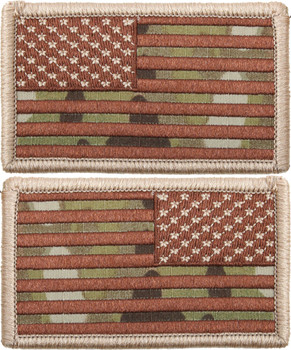Description
MultiCam Adjustable Subdued US Flag Mesh Back Operator Cap (9955)
* Front MultiCam Panels Made From Polyester Cotton Rip-Stop Material
* Rear Mesh Panels Made From 100% Polyester Khaki Mesh Material
* Features A 3 1/4" x 1 7/8" Fully Embroidered Subdued US Flag
* 2 Frontal Reinforced Air Vent Holes
* Vents & Mesh Back Provide Excellent Breathability
* Perfect For Hot & Arid Environments
* Adjustable Rear Hook & Loop Closure Strap
* Baseball Style Cap
* Unisex Design
* One Size Fits Most
About Multicam Camouflage and the OCP Uniform
MultiCam is camouflage pattern designed for use in a wide range of conditions produced by Crye Precision. Variants of it, some unlicensed, are in use with armed forces worldwide. The pattern is also available for civilian usage.
MultiCam has background colors of a brown to light-tan gradient and lime green blending in between, the main part consists of green to yellowish green gradient and finally dark brown and light pinkish blotches spread throughout the pattern. This allows for the overall appearance to change from greenish to brownish in different areas of the fabric, while having smaller blotches to break up the bigger background areas.
The MultiCam (Multi Cam) color scheme in Hex triplet is as follows:(i) Cream 524 B8A78B; (ii) Dark Brown 530 48352F; (iii) Tan 525 967860; (iv) Brown 529 6F573F; (v) Dark Green 528 5A613F; (vi) Olive 527 8C7D50; and (vii) Pale Green 526 85755C.
MultiCam is currently in use by the U.S. Special Operations Command, and some private military contractors. Several members of the U.S. Army's Charlie Company, 2d Battalion, 12th Infantry Regiment were also seen wearing MultiCam when followed by ABC News. In 2010, U.S. soldiers deployed to Afghanistan were issued MultiCam versions of the Army Combat Uniform, as the existing Universal Camouflage Pattern (UCP) was found to be inadequate for the terrain.
In May 2014, the Army selected a pattern similar to MultiCam called Scorpion W2 to replace UCP, naming it the Operational Camouflage Pattern (OCP). The originally Scorpion pattern was jointly developed by Crye Precision and the Army for the Objective Force Warrior program in 2002, and Crye made small adjustments for trademark purposes to create MultiCam. Because Scorpion is similar to MultiCam, the same color Velcro, buttons, and zippers can be reused. OCP resembles MultiCam with muted greens, light beige, and dark brown colors, but uses fewer beige and brown patches and no vertical twig and branch elements. On 31 July 2014, the Army formally announced that OCP would begin being issued in uniforms in summer 2015. Soldiers are allowed to wear uniforms and field equipment patterned in MultiCam until they can acquire OCP, which is allowed until MultiCam uniforms' wear-out date projected on 1 October 2018.
Some local, state and federal law enforcement agencies also make use of the pattern, including the Drug Enforcement Administration's Foreign-deployed Advisory and Support Teams (FAST) teams operating in Afghanistan as well as the U.S. Immigration and Customs Enforcement's Special Reaction Team, the Spokane, Washington Police Department, and the Oregon State Police SWAT team.
Operational Camouflage Pattern (OCP), originally codenamed Scorpion W2, is a military camouflage pattern adopted in the mid-2010s by the United States Army for use as the U.S. Army's main camouflage pattern on uniforms. This pattern is in the process of replacing the U.S. Army's previous Universal Camouflage Pattern (UCP) as the official combat uniform pattern for most U.S. soldiers. The pattern also superseded the closely related MultiCam, a pattern previously used for troops deploying to Afghanistan.
The original "Scorpion" pattern was developed by a joint venture of the Army's Natick Labs and Crye Precision as part of the Objective Force Warrior program more than a decade prior. It was then modified into MultiCam by Crye for commercial sales. The OFP version was modified from the initial pattern by Natick Labs. In July 2014, the Army announced that OCP could be used in the field by the summer of 2015.
In early April 2015, Army Chief of Staff Ray Odierno revealed that OCP uniforms were beginning to be issued to deployed soldiers going to Afghanistan, Iraq, Europe, and the Horn of Africa. The OCP ACU became available for soldiers to purchase starting July 1, 2015.






